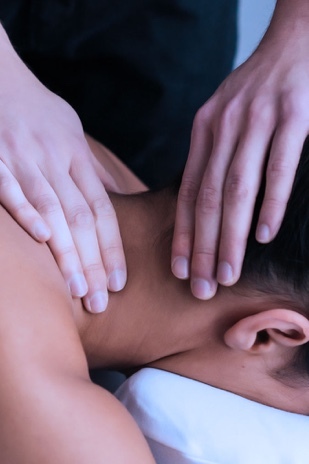Find a therapist
The Network of professional massage therapists of Quebec brings together more than 8,000 massage therapists
Member and insurer access
Find a therapist
The Network of professional massage therapists of Quebec brings together more than 8,000 massage therapists
A cervicalgia¹ is a pain located in the neck. Neck pain varies depending on the affected area, which can include vertebrae, tendons, ligaments, muscles and nerves.
There are two parts of the neck we can distinguish: the anterior part, the throat, and the posterior part, the nape. It is in the back of the neck that is located the neck skeleton composed of 7 vertebrae, known as cervical vertebrae. They are separated by intervertebral discs and connected by several ligaments.
These vertebrae movements are possible due the intervention of several muscles and ligaments. This set of muscles and vertebrae ensure the mobility and support of the head, which has a relatively high weight. The neck is the most mobile spine segment, which makes it very vulnerable to traumas and aging effects.

Torticollis is a muscular contracture caused by a false move, a hyperextension position, a bad working posture or a cold snap. Neck pain can be sharp and muscle contraction can restrict mobility, even forcing the inclination of the head.
The cervical sprain injury is a pathology caused by trauma, often as a result of a car accident or a strong impact during a contact sport. Known as “whiplash”, this injury causes neck pain and stiffness, as well as, in severe cases, headaches, dizziness, decreased concentration and visual impairment.
Cervicobracalgia is a compression located at the nerve roots that irrigate the arm. The pain then moves from the neck to the arm, forearm and hand and produces finger numbness. The compression may be due to muscle tension, a bad posture or stress.
Arnold’s neuralgia is a brachial nerve pain located in the neck’s deep muscle and is responsible for the motor and sensitive innervation of the scalp. The pain is diffused and rises behind the head and toward the eyes. Arnold’s neuroglia can result from a displaced vertebra, cervical muscle tension, inflammation following an accident, a sprain, a herniated disk or from high stress.
Cervical spondylosis is a degenerative disease that affects elderly people. It causes painful friction between vertebrae due to the cartilage decay (arthrosis) and decreases mobility.
The therapist is a muscle and joint specialist. His solid training allows him to efficiently act on several neck affections. Following the interview, the therapist will use, in appropriate cases, a massage to warm up tissues, reduce contractures and increase blood flow; essential oils and rubefiants (products with a muscular effect) as well as kinesitherapy techniques to restore the neck’s full amplitude and mobility.
To complete the session, the therapist will also recommend rehabilitation exercices.
The term therapist is used to signify a massage therapist, a kinesitherapist or an orthotherapist.
1.It is important to take note that your therapist cannot perform pathology diagnostics since only doctors have the competence to make a medical diagnosis. However, your therapist may act effectively to relieve your neck pain.
Find a therapist